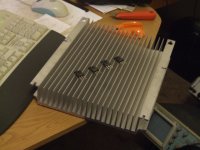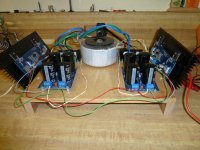....The officiale diyaudio guide for f5 builders in the list of materials says CL-60 but in the text sometimes refers to CL-12. I don't understand this passage.
I think it might mean CL1,2 = CL1 & CL2
Haven't seen that guide before, thanks.
I see what you mean, it's either an alternative part or a typo, I wouldn't worry about it, the parts list, drawings and photos all show the CL60.
Haven't seen that guide before, thanks.
I see what you mean, it's either an alternative part or a typo, I wouldn't worry about it, the parts list, drawings and photos all show the CL60.
so, I'll go straight. Sorry, I'm late cause my isp failure.
Output devices
Hi,
I'm new in DIYaudio. Are there any recommendations for available output devices other than IRFP240/9240 ?
For shure that has been discussed before, I just want to avoid browsing through 13000+ replies in this thread 😱
Regards
Norbert
Hi,
I'm new in DIYaudio. Are there any recommendations for available output devices other than IRFP240/9240 ?
For shure that has been discussed before, I just want to avoid browsing through 13000+ replies in this thread 😱
Regards
Norbert
There are numerous substitutions that you can make but Nelson's favourites are those shown in the schematics. Using anything different will affect the "tone" of the amp, maybe for the better, maybe for the worse, maybe audible or maybe not. The beauty of DIY is trying various ideas to see what suits you.
h_a is still selling genuine components so PM him for the genuine Pass sound.
h_a is still selling genuine components so PM him for the genuine Pass sound.
h_a is still selling genuine components so PM him for the genuine Pass sound.
Thank you - that is good news! Sorry for the newbie question: How can I find the PM address of "h_a"?
Regards
Norbert
Hi all
I've got an F5 built by Nelson Pass and bought from Reno Hi Fi. However, I don't use it anymore because I switched to active speakers, and hence I'd like to sell it. The amp works as new and is cosmetically perfect.
Anyone interested?
What's a reasonable price ($2675 new)?
Matthias
I've got an F5 built by Nelson Pass and bought from Reno Hi Fi. However, I don't use it anymore because I switched to active speakers, and hence I'd like to sell it. The amp works as new and is cosmetically perfect.
Anyone interested?
What's a reasonable price ($2675 new)?
Matthias
It's alive...the F5
Just put together an F5, my first Class A FET amp. While awaiting shipment of the diyAudio 4U case, I mocked up the amp with a couple of much-too-small heatsinks and a wood PCB holder.
Right channel fired up no problem. With a warmup, got .59v on both 0.47ohm resistors and .000v at the speaker outputs!
Left channel was the problem child. Could not adjust. Touched up a couple of solder joints that look a bit suspect, and reconnected. Biased up without a problem.
All the parts from Mouser and Jameco, small signal FETs from Spencer in Singapore. Used 18g teflon coated wire from local surplus store. Changes from original schematic: the CL-60 surge parts were attached directly on PEM from input to switch. Also, the dual 18v transformer was not in stock at Antec, so I used a 300VA 16v dual secondary instead. With my slightly elevate utility voltage here, I am getting 22.6 vdc at the PS unloaded. OK by me.
The temporary headsinks I am using for this are too small and get hot quickly, so I can only leave the amp on for 3-4 minutes to adjust. Next step is to add music.
Cannot do much more until the cabinet with heatsinks show up. My advice to someone wanting to build an F5 is to CHECK every resistor value before inserting, and set pots to zero ohms while in the board. I recommend putting in two pots first, check value, then add individual resistors after checking their values. Also put a clip-on heat sink for the small transistors/FETs when soldering on the board.
Thanks to all who offered help.
Just put together an F5, my first Class A FET amp. While awaiting shipment of the diyAudio 4U case, I mocked up the amp with a couple of much-too-small heatsinks and a wood PCB holder.
Right channel fired up no problem. With a warmup, got .59v on both 0.47ohm resistors and .000v at the speaker outputs!
Left channel was the problem child. Could not adjust. Touched up a couple of solder joints that look a bit suspect, and reconnected. Biased up without a problem.
All the parts from Mouser and Jameco, small signal FETs from Spencer in Singapore. Used 18g teflon coated wire from local surplus store. Changes from original schematic: the CL-60 surge parts were attached directly on PEM from input to switch. Also, the dual 18v transformer was not in stock at Antec, so I used a 300VA 16v dual secondary instead. With my slightly elevate utility voltage here, I am getting 22.6 vdc at the PS unloaded. OK by me.
The temporary headsinks I am using for this are too small and get hot quickly, so I can only leave the amp on for 3-4 minutes to adjust. Next step is to add music.
Cannot do much more until the cabinet with heatsinks show up. My advice to someone wanting to build an F5 is to CHECK every resistor value before inserting, and set pots to zero ohms while in the board. I recommend putting in two pots first, check value, then add individual resistors after checking their values. Also put a clip-on heat sink for the small transistors/FETs when soldering on the board.
Thanks to all who offered help.
Attachments
Use a fan to blow cooling air across those 'sinks until your bigger case arrives (it doesn't need much air to get rid of the heat)
Don't be afraid to run the unit HOT, 55*C is pretty normal around here, as they do sound more detailed and 'smoother' when hotter, particularly in comparison when some people use giant sinks to keep temp below 40*C.
.... my 2 cents
Don't be afraid to run the unit HOT, 55*C is pretty normal around here, as they do sound more detailed and 'smoother' when hotter, particularly in comparison when some people use giant sinks to keep temp below 40*C.
.... my 2 cents
The build posts I remember said to keep it below ambient + 25c. Not sure what the danger zone is for the outputs. I do have some fans, so I will take you advice when I put music to the amp.
On one amp build, I used a couple of small 'tunnel heatsinks' that offered free air 0.9*C/W and ran some slow air thru the pair and the sink just got to about +50*C (for a room temp of about 25*C) - in summer, it still ended up cycling at 56*C (+/- 3*C with a computer 'whisper quiet' 6" multispeed fan control.
I ended up using some flexible ducting to exhaust the 'hot air' outside - worked like a charm - still does, as I understand, and never a problem.
Mind you, I always use a dc protection cct with 'turn on' delay and a 'mute' function - simple and safe!
I ended up using some flexible ducting to exhaust the 'hot air' outside - worked like a charm - still does, as I understand, and never a problem.
Mind you, I always use a dc protection cct with 'turn on' delay and a 'mute' function - simple and safe!
So, that begs the question, do F5 users have soft start or speaker protection circuits installed? I haven't seen any in the few pictures posted, and NP did not appear to us them in his original manual.
I am concerned that a component malfunction could put DC on the outputs....not good.
I am concerned that a component malfunction could put DC on the outputs....not good.
F5
I have built four or five of these amps for friends. Only one failed and this put rail voltage across one of his speakers. Generally it is the bass speaker that cops it. This particular amp was the only one that didn't have speaker protection because he specifically asked for it to be omitted. Luckily it didn't damage his speaker because as soon as he realised something was wrong he turned the amp off. It is playing russian roulett not having speaker protection IMHO.
I have built four or five of these amps for friends. Only one failed and this put rail voltage across one of his speakers. Generally it is the bass speaker that cops it. This particular amp was the only one that didn't have speaker protection because he specifically asked for it to be omitted. Luckily it didn't damage his speaker because as soon as he realised something was wrong he turned the amp off. It is playing russian roulett not having speaker protection IMHO.
To me, adding a dc protection cct is a 'no brainer' and I'm totally puzzled about this extraordinary reluctance to use such a common sense addition - there are any number of good, reliable, low resistance, etc, etc modules (from Asia, for example) that cost little and work off easily acquired voltages already in the power amp.
For those people that have a 'thing' about possible relay problems, there are quite a few designs availably (also on this site) that use low Rdson power Fets/Transistors and are also quite simple and cheap to build.
To lose a couple of Power Fets, it costs some dollars for replacement matched Fets, and to lose a good quality bass driver will cost a few hundred but with no passive Xover, it can kill those favourite and highly prized midrange driver that aren't replaceable at all.
A good quality F5 will cost you maybe $6 - 800 to build - a good quality speaker will probably cost 10 times that, so why not use some easily added protection.
Now, if you're using simple Cmultipliers in your amp, the +ve and -ve rails often don't charge up at the same rate, so you DO need some delay while they initially charge up, but adding Capacitor Multipliers to the power supply is another story ...
For those people that have a 'thing' about possible relay problems, there are quite a few designs availably (also on this site) that use low Rdson power Fets/Transistors and are also quite simple and cheap to build.
To lose a couple of Power Fets, it costs some dollars for replacement matched Fets, and to lose a good quality bass driver will cost a few hundred but with no passive Xover, it can kill those favourite and highly prized midrange driver that aren't replaceable at all.
A good quality F5 will cost you maybe $6 - 800 to build - a good quality speaker will probably cost 10 times that, so why not use some easily added protection.
Now, if you're using simple Cmultipliers in your amp, the +ve and -ve rails often don't charge up at the same rate, so you DO need some delay while they initially charge up, but adding Capacitor Multipliers to the power supply is another story ...
I have built four or five of these amps for friends. Only one failed and this put rail voltage across one of his speakers. Generally it is the bass speaker that cops it. This particular amp was the only one that didn't have speaker protection because he specifically asked for it to be omitted. Luckily it didn't damage his speaker because as soon as he realised something was wrong he turned the amp off. It is playing russian roulett not having speaker protection IMHO.
How did that one fail?
- Home
- Amplifiers
- Pass Labs
- F5 power amplifier


